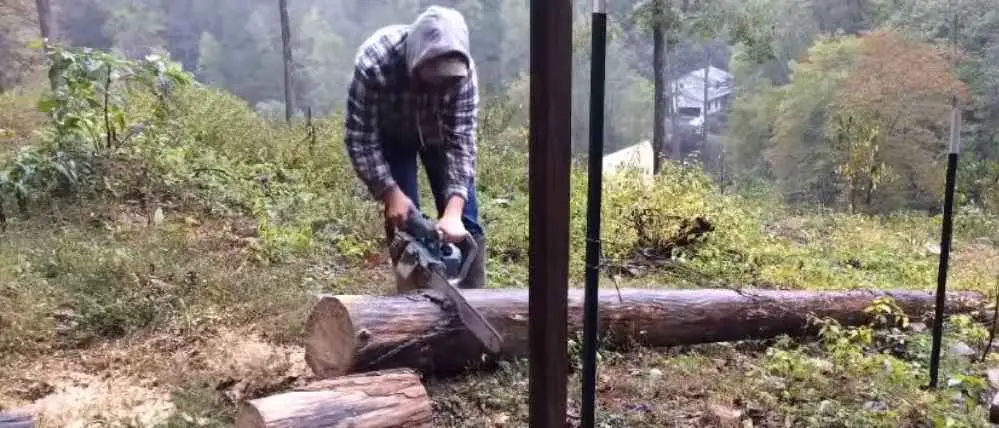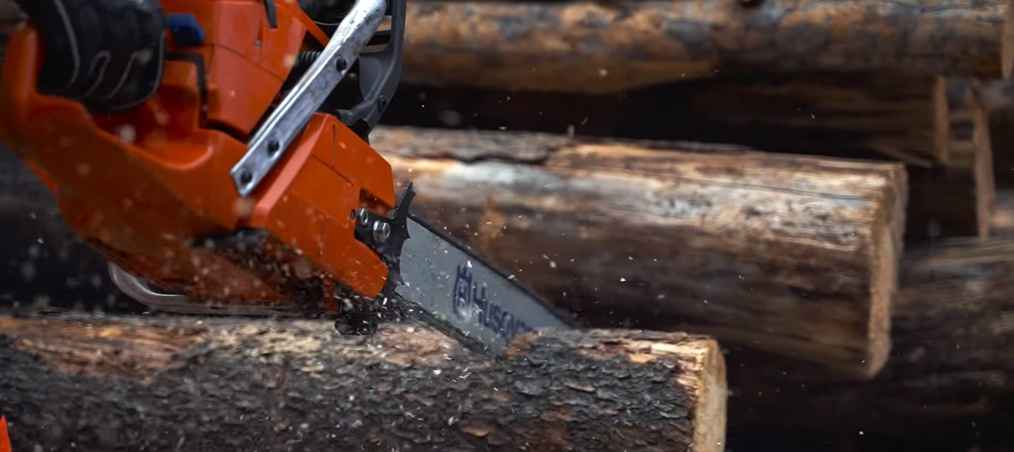You can use a chainsaw in the rain, but you need to take some precautions. First, make sure the saw is properly oiled and that the chain is not too loose. Second, be extra careful when cutting wet wood, as it can be slippery.
Third, try to avoid puddles and standing water, as this can cause the saw to overheat. Finally, keep an eye on the weather and stop working if lightning starts to strike.

Can You Use a Battery Chainsaw in the Rain?
If you’ve ever wondered whether or not you can use a battery chainsaw in the rain, the answer is yes! However, there are a few things to keep in mind if you’re going to be using your chainsaw in wet weather.
First of all, it’s important to make sure that your saw is properly protected from the elements.
If possible, try to keep it stored in a dry place when not in use. If you do need to use it in the rain, make sure to cover it with a tarp or something similar to keep it as dry as possible. Secondly, pay attention to your saw’s battery life.
In cold or wet weather, batteries tend to lose power more quickly than usual. So if you’re planning on using your saw for an extended period of time in bad weather, make sure to bring along extra batteries (or a backup charger) just in case. Finally, be extra careful when operating your chainsaw in slippery conditions.
Wet leaves and branches can make for a tricky cutting surface, so take your time and be cautious while cutting. And of course, always wear proper safety gear (including eye protection) when using any kind of power tool like a chainsaw.
Can You Cut Dry Wood With a Chainsaw?

Yes, you can cut dry wood with a chainsaw, but it’s not the best tool for the job. A sawzall or hand saw would be better suited for cutting dry wood.
Can You Cut Wet Wood With a Jigsaw?
You can cut wet wood with a jigsaw, but it is not recommended. Wet wood is more likely to splinter and break than dry wood, making it more difficult to get a clean, precise cut. In addition, the blade of the jigsaw will dull more quickly when cutting wet wood.
If you must cut wet wood, be sure to use a sharp blade and take your time for the best results.
Can You Cut Wet Wood With a Hand Saw?
It is possible to cut wet wood with a hand saw, but it is not advisable. Wet wood is more likely to split and chip than dry wood, so it is more difficult to cut cleanly. In addition, the blade of the hand saw can become gummed up with sap if you are cutting wet wood.
For these reasons, it is best to wait until the wood has had a chance to dry before attempting to cut it with a hand saw.
Can You Cut Wet Wood With a Reciprocating Saw?
Most people believe that you can’t cut wet wood with a reciprocating saw, but this simply isn’t true. While it’s not recommended to cut wet wood on a regular basis, it is possible to do so if you take the proper precautions.
First, make sure that your saw is in good working condition and that the blade is sharp.
Second, use a lower speed setting on the saw when cutting wet wood.
Finally, be extra careful when cutting wet wood, as it can be more slippery than dry wood. With these tips in mind, you should be able to safely and effectively cut wet wood with a reciprocating saw.
Can You Cut Wet Wood With a Table Saw?
Can you cut wet wood with a table saw? The answer is yes, but there are some things to keep in mind. First, the table saw blade will dull more quickly when cutting wet wood.
Second, the wood itself may split or warp if it is too wet. So, it is important to take care when cutting wet wood and to use a sharp blade.
Cutting Wet Wood Table Saw
Whether you’re a professional carpenter or a DIY enthusiast, there’s no doubt that a table saw is one of the most essential tools in your workshop. But what do you do when you need to cut wet wood? Most carpenters will tell you that cutting wet wood is a big no-no.
Wet wood is more likely to warp and swell, which can cause serious damage to your table saw blade. Not to mention, it can be extremely dangerous to try and cut wet wood on a power tool like a table saw.
However, there are certain situations where you may not have any other choice but to cut wet wood.
If this is the case, there are a few things you can do to minimize the risk of damage or injury.
First, make sure that your table saw blade is sharp and in good condition. A dull blade will struggle to cut through wet wood, putting unnecessary stress on the motor and increasing the chances of kickback.
Second, use a slower speed setting on your table saw. This will help prevent the blade from overheating and becoming damaged.
Finally, take extra care when feeding the wet wood into the blade, as it can easily slip and cause an accident.
Is It Okay to Use a Chainsaw on Wet Wood?
It is not advisable to use a chainsaw on wet wood as it can be dangerous. The saw can slip and cause serious injury. It is also more difficult to control the saw when the wood is wet.
Can You Use an Electric Chainsaw in the Rain?

If you’re looking to use an electric chainsaw in the rain, there are a few things you should keep in mind. First and foremost, make sure that the saw is properly insulated and that you’re using it with proper safety gear, including gloves and goggles.
Secondly, be aware that water can significantly reduce the performance of your saw, so it’s important to take extra care when operating it in wet conditions.
And finally, remember to dry off your saw as soon as possible after use to avoid rust and other damage.
CHAINSAW’S AND FENCE IN THE RAIN
Conclusion
This is a difficult question to answer, as many factors must be considered. Ultimately, it depends on the type of chainsaw, the conditions of the rain, and the user’s experience. If you are experienced with using a chainsaw and are familiar with the risks involved, then you may be able to use one in the rain.
However, if you are not experienced or comfortable using a chainsaw, it is probably best to avoid using one in the rain.